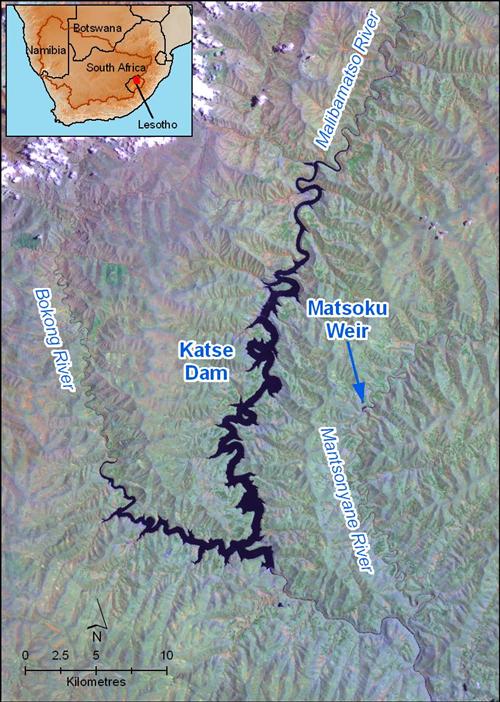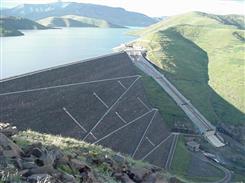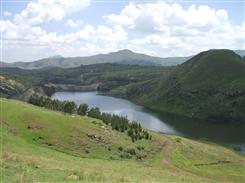There are currently two major dams in Lesotho, Mohale Dam and Katse Dam. These two structures, in conjunction with Matsoku Weir and the transfer tunnels between the two dams and one to South Africa, form Phase 1 of the Lesotho Highlands Water Project.
Katse Dam
Katse Dam is the major dam in the Senqu River catchment, located on the Malibamutso River.
Katse Dam is the key to the LHWP and is the highest dam in Africa at 185 m. The dam forms part of the first phase of the LHWP, usually referred to as Phase 1A. It forms the main collecting storage reservoir in Lesotho from which all transfers to South Africa are made through approximately 80 km of concrete-lined tunnels. The reservoir is very narrow, winding and deep, and exposes a surface area of 35,8 km2 at maximum capacity. The total effective storage capacity is 1 520 Mm3.

Katse Dam, Lesotho is the keystone in the Lesotho Highlands Water Project.
Source:Hatfield 2009
( click to enlarge )
Mohale Dam
The Mohale Dam forms the main storage element in Phase 1B of the Lesotho Highlands Water Project (LHWP) and is located on the Senqunyane River immediately downstream of the confluence with the Jorodane River. The dam is approximately 145 m high with a total capacity of 947 Mm³. The catchment area for the dam is 938 km² with a mean annual runoff in the order of 299 Mm³. The dam started to impound water in November 2002.
Muela Dam
The Muela Dam and Hydropower Plant were completed in Phase 1A of the Lesotho Highlands Water Project. The Muela Dam is a double curvature concrete arch dam with a height of 55m. The Lesotho Highlands Water Project is primarily a water transfer system, but at 'Muela the water en route to South Africa powers an underground hydroelectric power station that generates electricity to supply the needs of Lesotho. Before the station was built, electricity had to be bought from South Africa.
 Mohale Dam is a rock-fill dam located on the Senquyane River in Lesotho. Source:McKenzie 2004 ( click to enlarge ) |
 Muela Dam, located in the North of Lesotho, above the Muela Power Station. Source:Lesotho Water Commission 2009 ( click to enlarge ) |
Other Dams
In addition to the large dams of the Lesotho Highlands Water Project, there are several other smaller dams in Lesotho, primarily used for municipal water supply. These dams include:
-
Lionel Collet (also known as Thaba Phatsoa) - located close to the town of Hlotse, Lionel Collet Dam was completed in 1963 and stores water from the Fenyane River. It has a dam-wall height of 18m and a reservoir capacity of 1,75 Mm³;
-
Sebaboleng Dam - The Sebaboleng Dam is located in Lesotho, close to the city of Maseru, storing water from the Mejametalana river. Completed in 1969, it has a dam-wall height of 22m and a reservoir capacity of 1,245 Mm³. Sebaboleng Dam is located just upstream from the Maqalika Dam, connected by a spillway;
-
Maqalika Dam - Built between 1969 and 1971, Maqalika Dam is located just downstream from Sebaboleng, this dam is used as off-channel storage for water from the Caledon River, pumped out during periods of low flow when the water is carrying less sediment. Maqalika Dam is one of the main sources of water for the city of Maseru, with a storage capacity of approximately 3,7Mm³ (Kotelo-Molaoa 2007); and
-
Rasebala Dam - completed in 1993, Rasebala Dam provides most of the water for the town of Mafeteng and is located a few kilometres to the south-east of the town centre.
